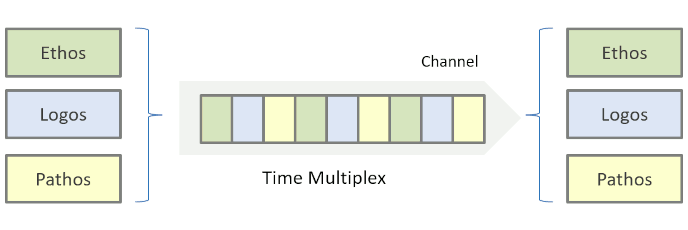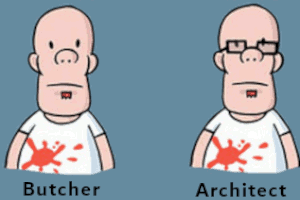Updated: Updated: Strategy
For this fourth part of this mini-series on presenting complex technical topics, I want to give more advice on overcoming the first major curses of speaking, which I introduced in the previous post:
The first curse of speaking: Hardly any idea worth sharing is linear. But a presentation is.
As a quick recap, parts 1 through 3 helped you develop and deliver a better technical presentation by focusing on the following aspects:
- Part 1: the ingredients you need to develop a credible and engaging presentation
- Part 2: the right proportions of ethos, logos, and pathos and how to adjust them
- Part 3: how to put those elements into a cohesive sequence
The underlying assumption that we worked with in Part 3 was that you can only have a linear sequence of ethos, logos, and pathos. That’s the first curse of speaking after all. Luckily, engineers have clever ways of transmitting multiple kinds of information across a single channel. Let’s see how that works.
Multiplexing: Mixing and Matching With Style
Multiplexing is a communications method that combines multiple signals into a single one. That’s how cable TV brought us the infamously many channels over a single wire (alas, it didn’t solve each channel having the same low-quality content). This form of multiplexing is called “frequency division”–each channel has its own frequency so that they don’t interfere. That works well for TV but turns out to be rather challenging for human-to-human communication. Luckily, we can use another form of multiplexing that works quite well: time division.
Time division allows you to quasi-simultaneously send multiple signals by transmitting each for a short time slice:

This approach works very well for presentations. You can deliver heavy content (lots of logos) and switch over to a metaphor or inject an anecdote to balance it out with some pathos before switching back to more logos. If you do this consistently, your audience will perceive it as getting both logos and pathos at the same time–our brains are quite amazing signal processors.
The Master of Multiplexing
A great example is once again from one of my favorite short talks about systemic improvements by Russ Ackoff. That’s certainly a logos-heavy topic (complex systems theory) but he manages to flip back and forth between making strong statements, using analogies, and injecting humor. For example, one of his key statements is fundamental to understanding systems:
A system is a whole that cannot be divided into independent parts. The defining properties of any system are properties of the whole, which none of its parts have. [3:53].
As that’s a lot of logos, he quickly multiplexes to an example that will be widely recognized by the audience: an automobile:
The essential property of an automobile is that it can carry you from one place to another. No part of an automobile can do that. [4:12]
Such an analogy helps the audience relate to the subject and to digest the message: He cleverly injects extra pathos, first by individually listing the pieces to illustrate his point:
The wheel can’t, the axle can’t, the seat can’t, the motor can’t.
Listing the elements supports his point but also raises some emotions, for example anticipation. After hearing three elements of a car that can’t move themselves, you likely anticipate a fourth one.
He then closes off this example by upping the pathos a bit more with some humor:
The motor can’t even carry itself from one place to another. [4:28]
To further shift towards pathos, he presents a second example: the human body. That’s a system that’s less technical and closer to home, making it even more relatable. And, as it would only seem fitting, he injects a healthy extra dose of humor:
You can write; your hand can’t write. That’s easy to demonstrate: cut it off, put it on a table, and watch what it does… nothing! [4:44]
He uses the energy built up by that pathos to get people to pay attention to his next statement:
And, therefore: when a system is taken apart, it loses its essential properties. [4:59]
He then swiftly returns to the example of the automobile to further illustrate this second key point.
Reverse Engineering a Speech
A lot is going on here, making several points worth pointing out:
- The time markers show that this whole section takes just about 1 minute. You can get a lot across in one minute, including examples and humor! “I only have time to give them the facts” doesn’t apply.
- His humor isn’t random jokes interspersed to get a laugh out of the audience. The humor itself also makes or supports an important content point. The “hand being cut off” is an example of a system losing its essential properties when you take it apart. So, this “joke” is also the transition to his next core statement.
- He keeps transitions very brief. Instead of elaborate lead-ins to the next section or an example, he connects all parts into a continuous flow. This not only saves time but also keeps the audience on the edge of their seats.
- Where a transition is needed, he uses pauses instead of using words. Notice the pause after “and therefore” at 4:59 above. That’s the signal that the next major statement is about to come. Think of the pause as the synchronization point for the time multiplex. For the geeks among us, it’s like the start bit of asynchronous serial communication!
Just following these few points will likely make you a much more effective technical presenter.
Explaining Anti-Fragile Systems with Pathos
I have used a similar narrative structure to explain anti-fragile systems, specifically the benefit of injecting disturbance to make systems more resilient (lots of logos). In my Architect Elevator YouTube Talk I also used two examples to illustrate this effect:
-
Firefighting. Firefighters practice by setting fire so they don’t see a fire the first time when your building is burning. Showing a picture of an aircraft mockup ablaze, I up the pathos by commenting that they are testing in the “staging environment, not the production environment”. But I also take care to bring the example back to the key point I am making, by describing what the fire crew is doing as “injecting disturbance”.
-
The Human Body. Not to follow Russ Ackoff too closely, the human body does make for many great analogies of complex system behavior. Vaccinations are literally injecting disturbance into your system. And make they make your body more resilient. There’s a lot of pathos in that example, particularly in 2020/21 when we are looking to fend off a major pandemic by means of vaccination.

I then use both examples to transition (multiplex) back to my next major point, which is that one can learn a lot about technical systems architecture from the real world (that transition would have benefited from a pause–that’s an aspect I continue to work on).
Visualizing Multiplexing
To help us multiplex our presentations we can use a –you almost guessed it–model. After all, we’re architects and architects love models. Let’s get our oscilloscope out and do that in the next post. Stay tuned!
Make More Impact as an Architect

The Software Architect Elevator helps architects and IT professionals to take their role to the next level. By sharing the real-life journey of a chief architect, it shows how to influence organizations at the intersection of business and technology. Buy it on Amazon US, Amazon UK, Amazon Europe




